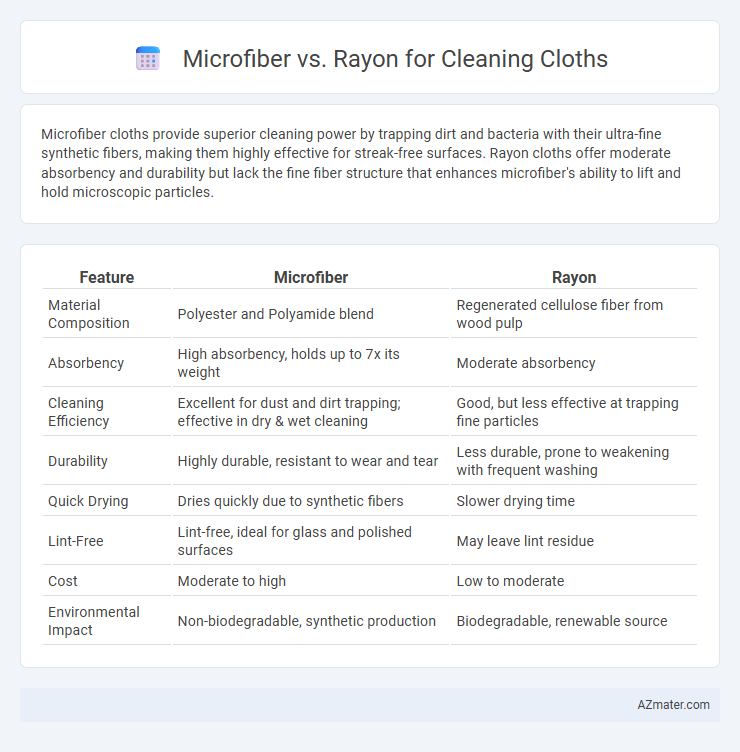Microfiber cloths provide superior cleaning power by trapping dirt and bacteria with their ultra-fine synthetic fibers, making them highly effective for streak-free surfaces. Rayon cloths offer moderate absorbency and durability but lack the fine fiber structure that enhances microfiber's ability to lift and hold microscopic particles.
Table of Comparison
| Feature | Microfiber | Rayon |
|---|---|---|
| Material Composition | Polyester and Polyamide blend | Regenerated cellulose fiber from wood pulp |
| Absorbency | High absorbency, holds up to 7x its weight | Moderate absorbency |
| Cleaning Efficiency | Excellent for dust and dirt trapping; effective in dry & wet cleaning | Good, but less effective at trapping fine particles |
| Durability | Highly durable, resistant to wear and tear | Less durable, prone to weakening with frequent washing |
| Quick Drying | Dries quickly due to synthetic fibers | Slower drying time |
| Lint-Free | Lint-free, ideal for glass and polished surfaces | May leave lint residue |
| Cost | Moderate to high | Low to moderate |
| Environmental Impact | Non-biodegradable, synthetic production | Biodegradable, renewable source |
Introduction to Cleaning Cloth Materials
Microfiber and rayon are two popular materials used in cleaning cloths, each offering distinct properties suited for various cleaning tasks. Microfiber is composed of synthetic fibers like polyester and polyamide, known for its exceptional absorption, durability, and ability to trap dirt and bacteria effectively. Rayon, a semi-synthetic fiber made from regenerated cellulose, provides a soft texture and good absorbency but generally lacks the durability and antimicrobial properties found in microfiber.
What is Microfiber?
Microfiber consists of synthetic fibers finer than one denier, typically made from polyester and polyamide, designed to trap dirt, dust, and liquids more effectively than traditional materials. Its unique split-fiber structure increases surface area, enabling superior absorption and cleaning efficiency while minimizing streaks. Microfiber cloths are highly durable, quick-drying, and resistant to bacteria growth, making them ideal for various cleaning applications compared to rayon.
What is Rayon?
Rayon is a semi-synthetic fiber made from regenerated cellulose derived from wood pulp, offering a soft texture and high absorbency ideal for cleaning cloths. Unlike microfiber, which is composed of synthetic polyester and nylon fibers, rayon provides a natural feel with good moisture-wicking properties. Its ability to hold dyes well and biodegradability makes rayon an eco-friendlier option in cleaning textiles compared to fully synthetic materials.
Absorbency Comparison: Microfiber vs Rayon
Microfiber cleaning cloths demonstrate superior absorbency due to their fine synthetic fibers, which create a large surface area to trap liquids effectively. Rayon, a semi-synthetic fiber derived from cellulose, offers moderate absorbency but tends to retain moisture less efficiently than microfiber. The dense weave and split fiber structure of microfiber enhances its capacity to hold multiple times its weight in liquid, making it more effective for cleaning tasks requiring high absorption.
Durability and Longevity
Microfiber cleaning cloths exhibit superior durability due to their tightly woven synthetic fibers that resist wear and tear better than rayon. Rayon cloths, made from regenerated cellulose fibers, tend to degrade faster with frequent washing and extended use, reducing their longevity. Microfiber maintains its cleaning efficiency and structural integrity over hundreds of laundering cycles, making it a more long-lasting option for cleaning tasks.
Cleaning Efficiency and Performance
Microfiber cloths outperform rayon in cleaning efficiency due to their ultra-fine synthetic fibers that trap dust, dirt, and bacteria more effectively than rayon's semi-synthetic fibers. Microfiber's split fibers increase surface area and create electrostatic forces, enhancing the removal of microscopic particles without the need for chemical cleaners. Rayon, while absorbent and soft, lacks the durability and particle-trapping capabilities of microfiber, making it less effective for thorough cleaning and repeated use.
Environmental Impact
Microfiber cleaning cloths are made from synthetic materials like polyester and nylon, which are derived from petroleum and contribute to microplastic pollution in waterways during washing. Rayon, a semi-synthetic fiber produced from cellulose in wood pulp, is biodegradable but often involves chemical-intensive manufacturing processes that can harm the environment. Choosing bamboo-based or organic rayon alternatives and properly maintaining microfiber cloths can reduce ecological footprints associated with these textiles.
Suitability for Different Cleaning Tasks
Microfiber excels in cleaning tasks requiring high absorption and trapping of dust, making it ideal for delicate surfaces and electronics due to its fine synthetic fibers that lift dirt efficiently. Rayon, made from natural cellulose fibers, is better suited for polishing and applying cleaning solutions because of its softness and smooth texture, which prevents scratching on glass and fine wood surfaces. Choosing between microfiber and rayon depends on the specific cleaning task, with microfiber favored for heavy-duty dirt removal and rayon preferred for gentle polishing and streak-free finishes.
Cost and Value Analysis
Microfiber cleaning cloths generally cost more upfront but offer superior durability and absorbency, providing better long-term value compared to rayon. Rayon cloths are often cheaper initially but wear out faster and lack the efficient dirt and moisture trapping properties found in microfiber. Evaluating cost per use, microfiber delivers enhanced performance and savings over time despite a higher initial investment.
Which is Better: Microfiber or Rayon?
Microfiber outperforms rayon for cleaning cloths due to its unique synthetic fibers that trap dust, dirt, and moisture more effectively, providing superior absorbency and durability. Rayon, while soft and lint-free, tends to absorb less liquid and may degrade faster with repeated washings. For high-efficiency cleaning tasks and long-lasting use, microfiber is the better choice over rayon.

Infographic: Microfiber vs Rayon for Cleaning Cloth
 azmater.com
azmater.com